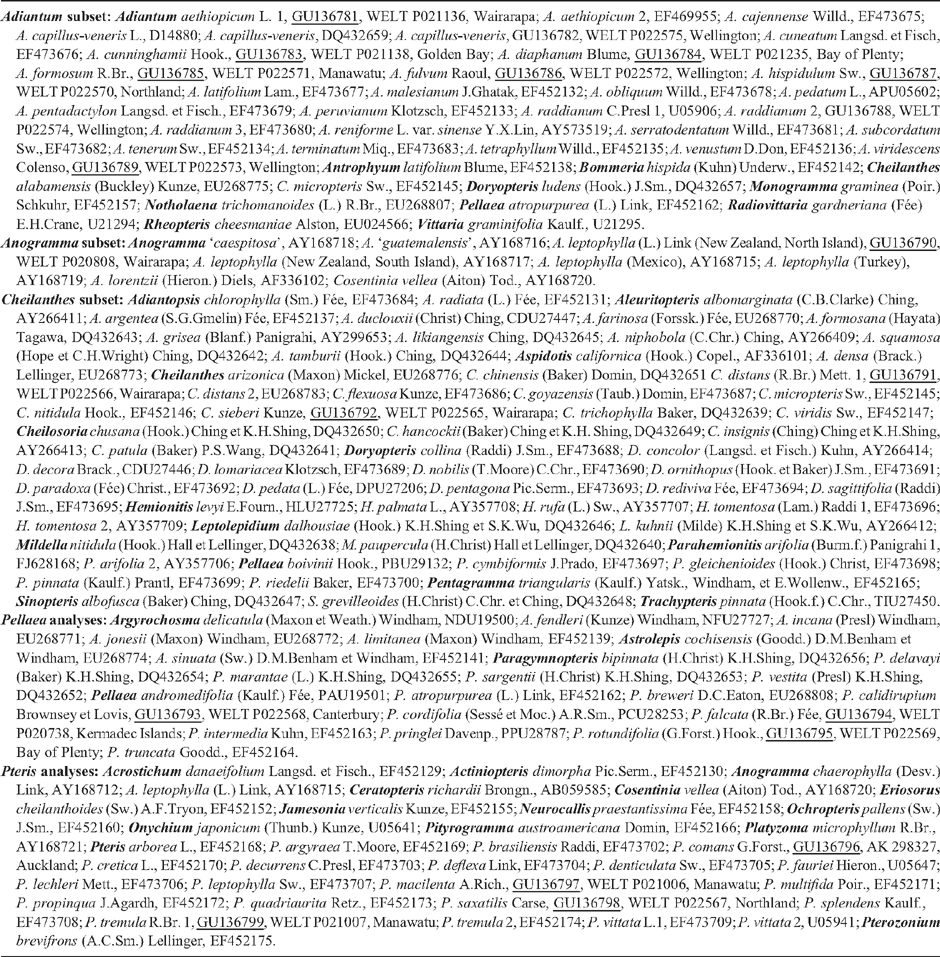Phylogeny and generic taxonomy of the New Zealand Pteridaceae ferns from chloroplast rbcL DNA sequences
Whitney L. M. Bouma A , Peter Ritchie A and Leon R. Perrie B CA School of Biological Sciences, Victoria University of Wellington, PO Box 600, Wellington, New Zealand.
B Museum of New Zealand Te Papa Tongarewa, PO Box 467, Wellington, New Zealand.
C Corresponding author. Email: leonp@tepapa.govt.nz
Australian Systematic Botany 23(3) 143-151 https://doi.org/10.1071/SB09047
Submitted: 30 October 2009 Accepted: 17 March 2010 Published: 14 July 2010
Abstract
Previous molecular phylogenetic studies of the species-rich Pteridaceae fern family have revealed that many of its constituent genera are not monophyletic. Within this context, we generated rbcL chloroplast DNA sequences for the 17 Pteridaceae species indigenous to New Zealand to assess how they are related to the type species of their genus. Of the five genera presently recognised in New Zealand, no taxonomic change is needed for the species of Anogramma, or, probably, of Cheilanthes and Pellaea. In contrast, most species presently attributed to Pteris, including those in New Zealand, probably do not belong there. The status of Adiantum remains unclear, although the New Zealand species are not especially closely related to the type species. The Adiantum species in New Zealand belong to a wide-ranging, principally southern hemisphere, clade that appears to be pivotal to resolving the relationships of Adiantum, although it has been little sampled. The closest relatives of the New Zealand species are in Australia and South America for Cheilanthes, Australia and South-east Asia for Pellaea, and the south-western Pacific for both of the Pteris lineages in New Zealand, whereas Anogramma leptophylla (L.) Link is subcosmopolitan.
Acknowledgements
We thank Peter Beveridge, Skip Bouma, Patrick Brownsey, Ewen Cameron, Ellen Cieraad, David Glenny, Richard Perrie, Lara Shepherd and Barry Sneddon for assistance with collecting samples, and Patrick Brownsey and anonymous reviewers for constructive comments that improved the manuscript. W. B. acknowledges the support of Te Papa’s MSc scholarship in Molecular Systematics.
Brownsey PJ
(2001) New Zealand’s pteridophyte flora – plants of ancient lineage but recent arrival? Brittonia 53, 284–303.

Doyle JJ, Doyle JD
(1990) Isolation of plant DNA from fresh tissue. Focus 12, 13–15.

Dubuisson J-V,
Hennequin S,
Douzery EJP,
Cranfill RB,
Smith AR, Pryer KM
(2003)
rbcL phylogeny of the fern genus Trichomanes (Hymenophyllaceae), with special reference to neotropical taxa. International Journal of Plant Sciences 164, 753–761.
| Crossref | GoogleScholarGoogle Scholar |
CAS |

Hasebe M,
Ito M,
Kofuji R,
Ueda K, Iwatsuki K
(1993) Phylogenetic relationships of ferns deduced from rbcL gene sequence. Journal of Molecular Evolution 37, 476–482.
| Crossref | GoogleScholarGoogle Scholar |
CAS |
PubMed |

Hennequin S,
Ebihara A,
Ito M,
Iwatsuki K, Dubuisson J-V
(2006) New insights into the phylogeny of the genus Hymenophyllum s.l. (Hymenophyllaceae): revealing the polyphyly of Mecodium. Systematic Botany 31, 271–284.
| Crossref | GoogleScholarGoogle Scholar |

Huelsenbeck JP, Ronquist FR
(2001) MrBayes: Bayesian inference of phylogeny. Biometrics 17, 754–755.
|
CAS |

Kirkpatrick REB
(2007) Investigating the monophyly of Pellaea (Pteridaceae) in the context of a phylogenetic analysis of cheilanthoid ferns. Systematic Botany 32, 504–518.
| Crossref | GoogleScholarGoogle Scholar |

Morton CV
(1970) The lectotype of Polypodium leptophyllum L. American Fern Journal 60, 101–103.
| Crossref | GoogleScholarGoogle Scholar |

Nakazato T, Gastony GJ
(2003) Molecular phylogenetics of Anogramma species and related genera (Pteridaceae: Taenitidoideae). Systematic Botany 28, 490–502.

Perrie LR, Brownsey PJ
(2005) Insights into the biogeography and polyploid evolution of New Zealand Asplenium from chloroplast DNA sequence data. American Fern Journal 95, 1–21.
| Crossref | GoogleScholarGoogle Scholar |

Perrie L, Brownsey P
(2007) Molecular evidence for long-distance dispersal in the New Zealand pteridophyte flora. Journal of Biogeography 34, 2028–2038.
| Crossref | GoogleScholarGoogle Scholar |

Prado J,
Rodrigues CDN,
Salatino A, Salatino MLF
(2007) Phylogenetic relationships amongst Pteridaceae, including Brazilian species, inferred from rbcL sequences. Taxon 56, 355–368.

Rothfels CJ,
Windham MD,
Grusz AL,
Gastony GJ, Pryer KM
(2008) Toward a monophyletic Notholaena (Pteridaceae): resolving patterns of evolutionary convergence in xeric-adapted ferns. Taxon 57, 712–724.

Ruhfel B,
Lindsay S, Davis CC
(2008) Phylogenetic placement of Rheopteris and the polyphyly of Monogramma (Pteridaceae s.l.): evidence from rbcL sequence data. Systematic Botany 33, 37–43.
| Crossref | GoogleScholarGoogle Scholar |

Schuettpelz E, Pryer KM
(2007) Fern phylogeny inferred from 400 leptosporangiate species and three plastid genes. Taxon 56, 1037–1050.
| Crossref | GoogleScholarGoogle Scholar |

Schuettpelz E,
Schneider H,
Huiet L,
Windham MD, Pryer KM
(2007) A molecular phylogeny of the fern family Pteridaceae: assessing overall relationships and the affinities of previously unsampled genera. Molecular Phylogenetics and Evolution 44, 1172–1185.
| Crossref | GoogleScholarGoogle Scholar |
CAS |
PubMed |

Shepherd LD,
Perrie LR,
Parris BS, Brownsey PJ
(2007) A molecular phylogeny for the New Zealand Blechnaceae ferns from analyses of chloroplast trnL–trnF DNA sequences. New Zealand Journal of Botany 45, 67–80.

Shepherd LD,
Holland BR, Perrie LR
(2008) Conflict amongst chloroplast DNA sequences obscures the phylogeny of a group of Asplenium ferns. Molecular Phylogenetics and Evolution 48, 176–187.
| Crossref | GoogleScholarGoogle Scholar |
CAS |
PubMed |

Smith AR,
Pryer KM,
Schuettpelz E,
Korall P,
Schneider H, Wolf PG
(2006) A classification for extant ferns. Taxon 55, 705–731.
| Crossref | GoogleScholarGoogle Scholar |

Thompson JD,
Gibson TJ,
Plewniak F,
Jeanmougin F, Higgins DG
(1997) The ClustalX windows interface: flexible strategies for multiple sequence alignment aided by quality analysis tools. Nucleic Acids Research 25, 4876–4882.
| Crossref | GoogleScholarGoogle Scholar |
CAS |
PubMed |

Zhang G,
Zhang X,
Chen Z,
Liu H, Yang W
(2007) First insights in the phylogeny of Asian cheilanthoid ferns based on sequences of two chloroplast markers. Taxon 56, 369–378.




